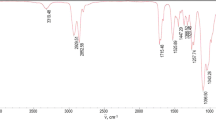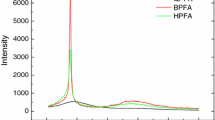Summaries
Polyurethane coatings with different network compositions were prepared in well-defined model systems as well as commercially-available formulations. The properties, such as glass-transition temperature, hardness and surface free energy, of the model network were tuned by the choice of the ingredients. All coatings were studied with respect to their bulk properties as well as their surface properties. It was found that by the addition of a fluorinated additive, the surface free energy of the coating was lowered by approximately 15mNm−1, leaving the bulk properties intact. It was also shown that these polyurethane coatings are able to adapt their surface free energy in a reversible manner when exposed to water. The magnitude and rate of surface rearrangement is strongly dependent on the network density of the coating. The effect of coating properties on the formation of a biofilm and subsequent adhesion of diatoms was studied on a selection of the coatings used in this study, and the results obtained are discussed.
Résumé
On a préparés des revêtements de polyuréthane ayant de différentes compositions de réseau et selon des systèmes modèles bien définis. On a préparé aussi des formulations qui sont disponibles dans le commerce. Les propriétés telles que la température de la transition vitreuse, la dureté et l’énergie libre de surface du réseau modèle, étaient ajustées grâce au choix des ingrédients. Tous les revêtements ont été étudiés quant à leurs propriétés de bulk aussi bien qu’à leurs propriétés de surface. On a trouvé que, gráce à l’addition d’un additif fluoré, l’énergie libre de surface du revêtement a été diminuée par approximativement 15mNm−1 sans changer les propriétés de bulk. Il a été montré également que ces revêtements polyuréthane sont capables d’adapter leur énergie libre de surface d’une manière réversible quand ils sont exposés à l’eau. Le degré et le taux de la réorganisation de la surface dépendent beaucoup de la densité du réseau du revêtement. L’effet des propriétés des revêtements sur la formation d’un biofilm et sur l’adhésion subséquent de diatomées a été étudié pour une sélection des revêtements utilisés au cours de cette étude et les résultats ainsi obtenus y sont discutés.
Zusammenfassung
Polyurethanlacke mit verschiedenen Vernetzungsmustern wurde in einem gut definierten Modellsystem sowie mit kommerziell erhältlichen Formulierungen hergestellt. Eigenschaften wie die Glastransistionsenergie, Härte und freie Oberflächenenergie der Modellvernetzung wurde durch die Wahl der Zutaten bestimmt. Wir studierten die Großmengeneigenschaften und die Obverflächeneigenschaften der Lacke und fanden, daß die Hinzufügung von fluorinierten Additiven die freie Oberflächenenergie des Lackes um ca. 15mNm−1 verringerte, ohne die Großmengeneigenschaften zu beeinflussen. Wir zeigten auch, daß die freie Oberflächenenergie der Polyurethanlacke unter Wasseraussetzung umgekehrt werden kann. Die Stärke und Geschwindigkeit der Oberflächenänderung hängt stark von der Vernetzungsdichte des Lackes ab. Wir studierten auch den Effekt des Lackes auf die Bildung von Biofilmen und die nachfolgende Haftung von Diatomen an einigen der Lacke, die in dieser Studie verwendet wurden. Die Ergebnisse werden hier diskutiert.
Similar content being viewed by others
References
Schmidt D L, C E Coburn, B M DeKoven, G E Potter, G F Meyers and D A Fischer,Nature,368, 39, 1994
Kobayashi H and M J Owen,Trends Polymer Sci,3, 10, 1995
Tingey K G, J D Andrade, R J Zdrahala, K K Chittur and R M Gendreau,Surface Characterization of Biomaterials, (ed) B D Ratner, 255, Elsevier Science Publishers BV, Amsterdam, 1988, ISBN 0444430164
Deng Z and H P Schreiber,J Adhesion,36, 71, 1991
Lee S H and E Ruckenstein,J Colloid Interface Sci,120, 529, 1987
Yasuda H, A Sharma and T Yasuda,J Polym Sci: Polym Phys Ed,19, 1285, 1981
Tezuka Y and K Imai,Chemically Modified Surfaces Vol 2: Chemically Modified Surfaces in Science and Industry, (eds) D E Layden and W T Collins, 643, Gordon and Breach Science Publishers SA, London, 1988, ISBN 2881242219
Tezuka Y, T Ono and K Imai,J Colloid Interface Sci,136, 408, 1990
Tezuka Y, H Kazama and K Imai,J Chem Soc Faraday Trans,87, 147, 1991
Takabara A, N J Jo and T Kajiyama,J Biomater Sci Polym Ed,1, 17, 1989
Chen J-H, and E Ruckenstein,J Colloid Interface Sci,135, 496, 1990
Kaziyama T and A Takahara,J Biomater Appl,6, 42, 1991
Brummer P M and K Knutson,Macromolecules,23, 4357, 1990
Ratner B D, P K Weathersby, A S Hoffman, M A Kelly and L H Scharpen,J Appl Polym Sci,22, 643, 1978
Grasel T G, J A Pierce and S L Cooper,J Biomed Mater Res,21, 815, 1987
Schneider N S, J L Illinger and F E Karasz,J Appl Polym Sci,47, 1419, 1993
Johnson E, S Bullock, J Uilk, P Gatenholm and K J Wynne,Macromolecules,32, 8173, 1999
Pike J K, T Ho and K J Wynne,Chem Mater,8, 856, 1996
Kober M and B Wessle,J Appl Polym Sci,54, 793, 1994
Lukas J, R N S Sodhi and M V Sefton,Macromol Symp,109, 185, 1996
Yu X H, A Z Okkema and S L Cooper,J Appl Polym Sci,41, 1777, 1990
Zhuang H, K G Marra, T Ho, T M Chapman and J A Gardella Jr,Macromolecules,29, 1660, 1996
Freij-Larsson C, M Kober, B Wessle, E Willquist and P Tengvall,J Appl Polym Sci,49, 815, 1993
Tang Y W, J-P Santeere, P S Labow and D G Taylor,J Appl Polym Sci,62, 1133, 1996
Owens D K and R C Wendt,J Appl Polym Sci,13, 1741, 1969
Bakker D P, F M Huijs, J D Vries, J W Klijnstra, H J Busscher and H C van der Mei,Colloids and Surfaces B: Biointerfaces,32, 179, 2003
Wouters M, J van Zanten, F Huijs and T Vereijken,J Coat Technol, accepted for publication
van Krevelen D W,Properties of Polymers, (3rd edition), Elsevier, 1990, ISBN 0444881603
Game Ph, D Sage and J P Chapel,Macromolecules,35, 917, 2002
Extrand C W and Y Kumagi,J Colloid Interface Sci,184, 191, 1996
Owen M J,J Appl Polym Sci,35, 895, 1988
Kobayashi H and M J Owen,Macromolecules,23, 4929, 1990
Kobayashi H,Makromol Chem,194, 259, 1993
Fernández Estarlich F, S A Lewey, T G Nevell, A A Thorpe, J Tsibouklis and A C Upton,Biofouling,16, 263, 2000
Schneider R P,J Colloid Interf Sci,182, 204, 1996
Tsibouklis J, M Stone, A A Thorpe, P Graham, V Peters, R Heerlien, J R Smith, K L Green and T G Nevell,Biomaterials,20, 1229, 1999
Brady R F, JrProg Org Coat,35, 31, 1999
Author information
Authors and Affiliations
Corresponding author
Rights and permissions
About this article
Cite this article
Wouters, M., van Zanten, J., Vereijken, T. et al. Fluorinated polyurethane coatings with adaptable surface properties. Surface Coatings International Part B: Coatings Transactions 89, 23–30 (2006). https://doi.org/10.1007/BF02699611
Issue Date:
DOI: https://doi.org/10.1007/BF02699611




